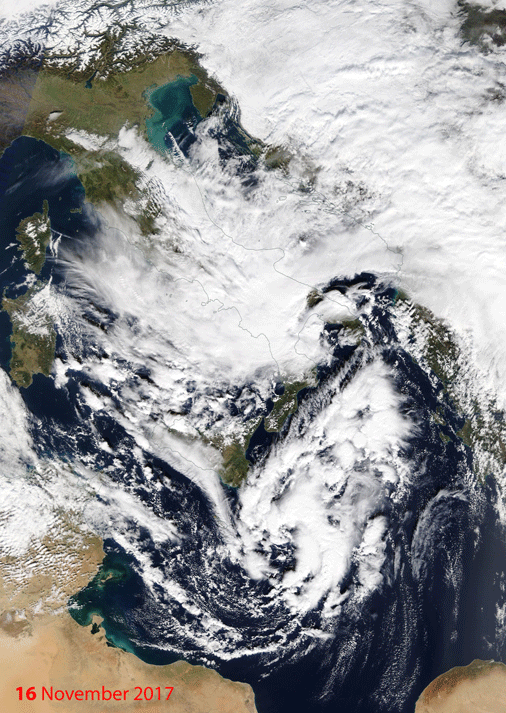Mediterranean hurricanes expected to increase in strength by end of century

Hurricane-strength storms in the Mediterranean could hit the region with increasing power by the end of the 21st century, growing to robust Category 1 strength, according to a new study in the AGU journal Geophysical Research Letters.
Although Mediterranean tropical-like cyclones, known as "medicanes," are predicted to be less frequent in the future, they will develop a more robust hurricane-like structure and last longer, with higher winds and more rain, according to the new study. The new research predicts the change in storms will begin to emerge at the end of the century, from 2081 to 2100, with stronger storms appearing in the autumn.
Medicanes arise in the Mediterranean when an extratropical cyclone blunders into the sea basin and transforms to a more tropical cyclone-like storm, with symmetric structure and convective clouds circling a warm core and an eye-like center.
Extratropical cyclones are driven by temperature contrasts across the storm front and blow strongest in the tropopause, about 12 kilometers (8 miles) above Earth's surface. In contrast, tropical cyclones' strongest winds are at the surface, which can often be more damaging. Tropical cyclones are called hurricanes in the Atlantic and typhoons in the Pacific west of the International Dateline.
Currently, medicanes of tropical depression intensity or stronger occur a few times a year, but rarely reach the strength of a Category 1 hurricane. Tropical depressions have a maximum wind speed of 63 kilometers (39 miles) per hour.
"In their mature stage, medicanes are similar to hurricanes in the Caribbean," said Juan J. González-Alemán, a researcher at the University of Castilla-La Mancha in Toledo, Spain, and the lead author of the new study. "Even under an intermediate climate scenario, we will likely see a lower frequency of these storms, but when they occur, they will have a higher chance of reaching Category 1."
Other studies have predicted an increase in storm intensity in the Mediterranean with climate change, but the new study is the first to utilize a global coupled model, which combines atmospheric and ocean circulation models. Including ocean processes in the model is important for a realistic representation of medicanes, González said. The new model is more robust and addresses the precipitation intensity, tropicality and power dissipation indexes of future storms, according to González.
Tropicality is an indicator of how hurricane-like the storm's structure is, and power dissipation describes its potential for destruction. The new study predicts both tropicality and power dissipation will increase in magnitude in the coming century. The model could not discard the possibility that storms may reach Category 2 strength, although the main finding is for strong Category 1 storms, González said.
A tropical storm becomes a Category 1 hurricane when sustained winds exceed 119 kilometers (74 miles) per hour and a Category 2 at 154 kilometers (96 miles) per hour.
"The Mediterranean Sea is over-populated, so though smaller than Caribbean hurricanes, the impact on society from medicanes may be worse. They have a high chance of impacting people and societal interests," González said.
More information: Juan J. González-Alemán et al. Potential Increase in Hazard From Mediterranean Hurricane Activity With Global Warming, Geophysical Research Letters (2019). DOI: 10.1029/2018GL081253
Journal information: Geophysical Research Letters
Provided by American Geophysical Union
This story is republished courtesy of AGU Blogs (http://blogs.agu.org), a community of Earth and space science blogs, hosted by the American Geophysical Union. Read the original story here.





















